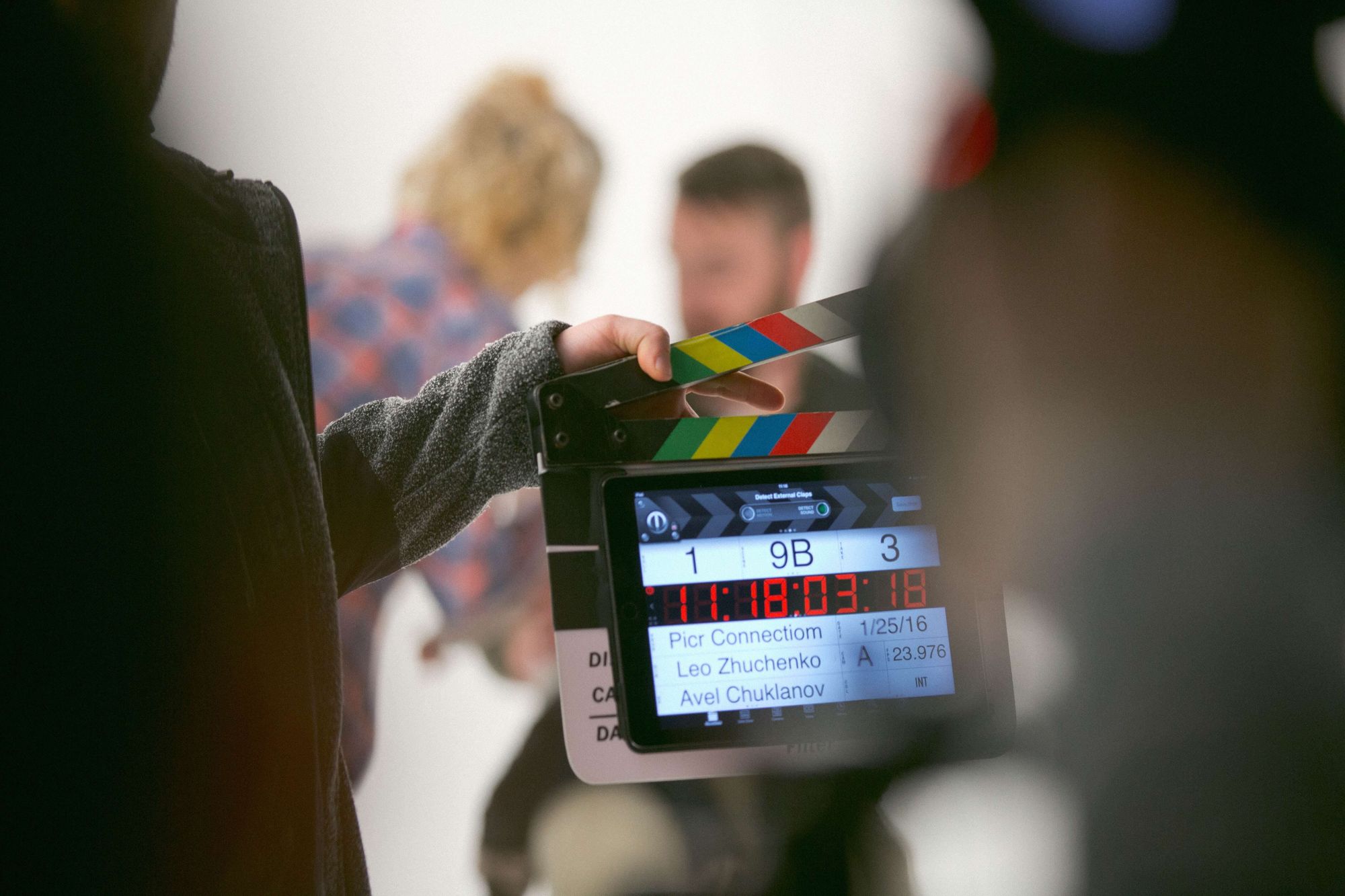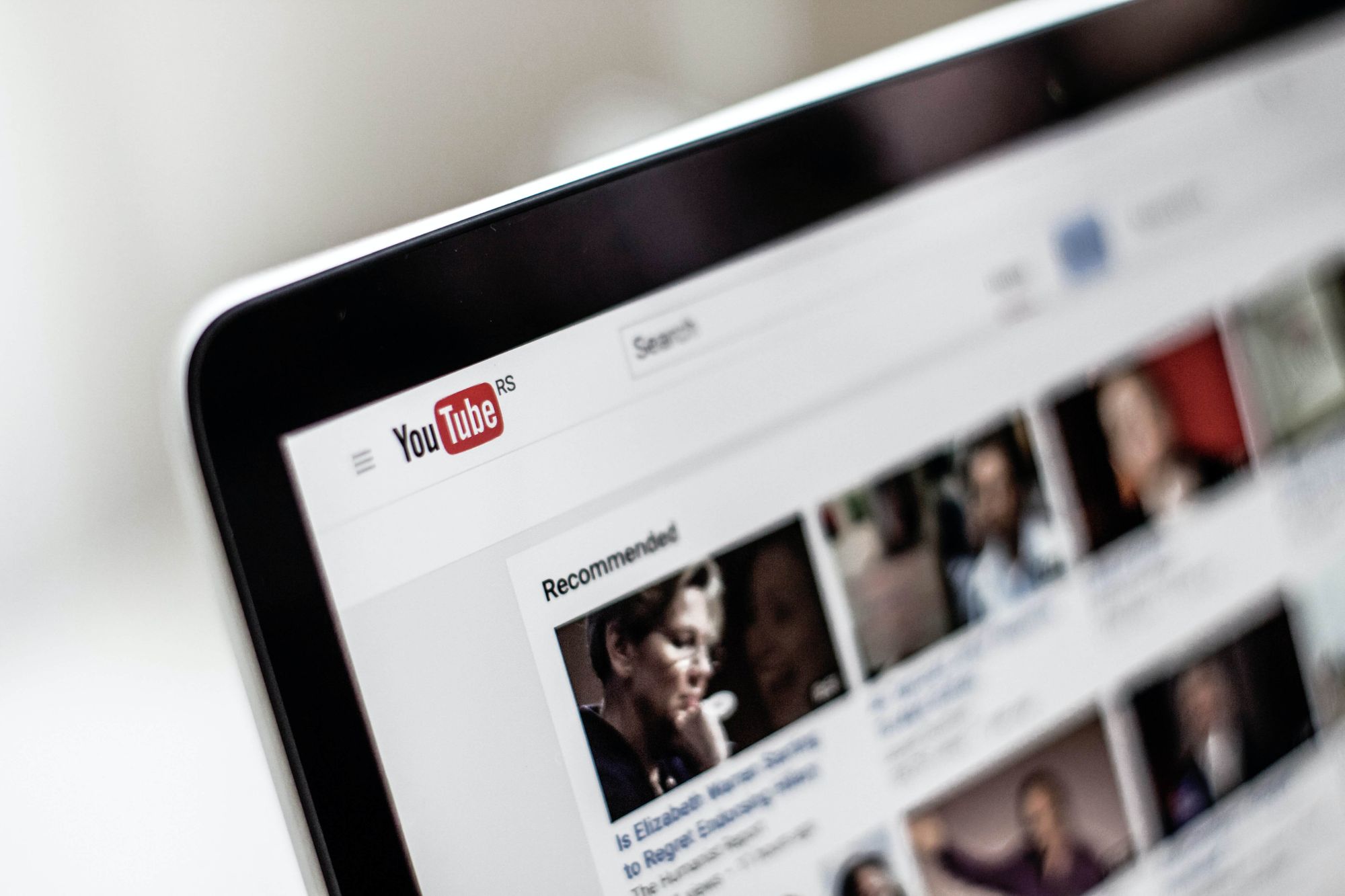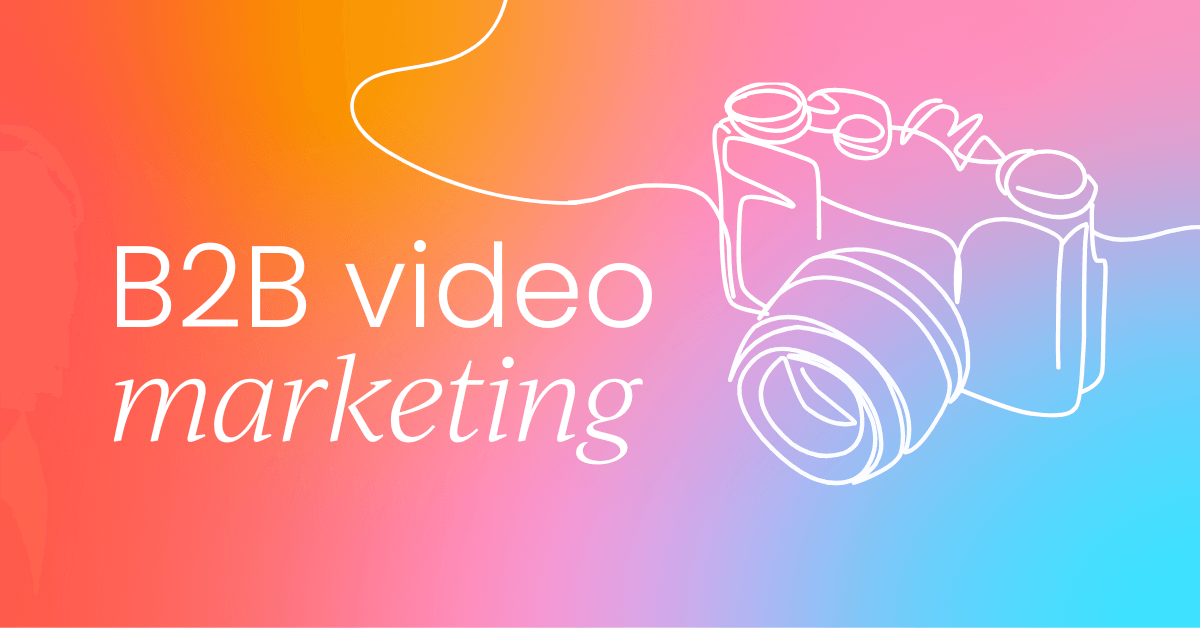Video marketing is a powerful tool in the B2B space.
The number of digital video viewers worldwide is expected to reach 3.5 billion.
But video is already a popular medium in marketing, with 86% of marketing professionals using video as a marketing tool, and it’s cited as the favorite type of content that people like to see from brands on social media.
For some B2B brands, they may think their industry isn’t “interesting” enough to warrant video content, but that’s simply not the case! Video can be leveraged in so many ways to help connect your brand to your audience, build trust, and boost sales.
In this guide, we’ll take you through the importance of video marketing and tips for producing videos. You’ll also find plenty of resources linking to previous blog articles we’ve written about video in B2B.
- What is B2B video marketing?
- Why B2B video marketing is important?
- How to get started with video marketing?
- Video production tips for B2B marketers
- How to feel comfortable in front of the camera for marketing videos
What is B2B video marketing?
B2B video marketing is all about using videos to promote products, services, or brands to other businesses. It's like creating videos that speak directly to other companies. The idea is to grab their attention and show them how your solutions can solve their problems or meet their needs.
These videos can be:
- Demos,
- Interviews,
- Webinars, or even
- Customer stories.
You can share them on your website, social media, through emails, or at industry events. B2B video marketing helps you engage other businesses visually, communicate effectively, build trust, and generate leads. It's a powerful way to boost your overall marketing strategy and drive more business from other companies.
Why B2B video marketing is important
As the most prolific content medium online, video is crucial for any business regardless of its industry.
Video marketing can increase your brand awareness by getting you more exposure and engagement, increase the visibility of your products which can lead to more sales, and even provide an SEO boost, helping you rank higher in search results.
Video is versatile, allowing you to engage with your audience on social media, email, and on your website. You can produce educational content like product demos and industry thought pieces, or you can sell your products and services with customer testimonials and case studies.
How to get started with B2B video marketing
Any brand can get started with video. You don’t need a ridiculous budget, expensive equipment, or crazy special effects to make exciting video content. You just need a clear direction and the drive to make it happen.
If you want to make video a full-formed part of your social media strategy, you could join the fastest growing social platform, TikTok, which is rapidly becoming a tool in the B2B space, thanks to their platform TikTok for Business.
58% of adults between 18 and 29 use TikTok, making it the social media platform of choice for Gen-Z. As this demographic rises through the workforce, we’re likely to see a lot more B2B marketers engaging with the platform.
With its emphasis on short, low-budget videos, TikTok is both a cheap way to produce content and the ideal platform for brands to build personal, emotional connections with their audience. It’s also the ideal way to demonstrate quick product hacks, show behind-the-scenes clips, and demonstrate the fun, personable side of your company.
Check out our article looking at the reasons why your brand should be on TikTok:

When starting out, you need to understand the basics of video before you can get shooting underway. Here’s what you need to consider when implementing video marketing:
Create a posting schedule
You need to think of your video content in the long term, rather than just posting things at random. Maintaining a consistent publishing schedule will keep your audience coming back for more videos, and implementing new campaigns will keep them engaged.
Choose your type of videos
There are many angles you can take with video for B2B, and you likely want to focus on just a couple to get started. There are how-to’s, testimonials, demonstrations, case studies, teasers, company news, interviews, blog post summaries, behind the scenes, and many more.
Your choice will depend on the goals you want to achieve with video. If you want to help your audience understand more about what you do, a product/service demonstration can be a great video to start with.
Tell stories in creative ways
The most memorable videos and ads are the ones that tell a story, they’re not about the hard sell. If you want your video to engage your audience, it needs to connect with them. Tell the story of your brand with an engaging story arc from start to finish. Drive that connection through a narrative that builds emotion.
Start with a great hook
With so much video content out there, those first few seconds are crucial. You need to give immediate clarity to what your video is about, and why it’s worth the viewer’s time to watch. To do this, you need an attention-grabbing hook that puls them in immediately so they watch through to the end.
Include CTAs
Just like with any piece of content, you need a clear call to action so your audience knows what to do next. It doesn’t always have to be a sale, it can include anything from following your social media page, sharing the video with friends or colleagues, leaving a comment, or encouraging viewers to engage with other content.
Share your content
Once your video is shot and edited to perfection it needs to be shared. There are a number of hosting platforms to choose from for uploading your video, which can then be shared on social media or embedded on your website or in email newsletters.
Need to find some new video marketing tools to add to your B2B arsenal? Check out our article below.

Video production tips for B2B marketers
Even if you think you operate in a “boring” industry, there’s plenty that can be done with video.
Whether it’s educational/instructional content to help users with your products, reviews from trusted sources, or behind-the-scenes looks at the day-to-day business operations, video can be leveraged in so many ways to help connect your brand to your audience, build trust and boost revenue.
But if you’re new to video marketing, take a look at our top tips for getting started, looking at everything from lighting to editing so you can create the perfect video content for your B2B brand.
Lighting
Lighting is essential for filming and can make a huge difference to the quality of the finished product. Natural light is a great lighting source for videos, so it’s best to film your footage in the morning or evening when the light is at its softest (midday sun can cast harsh shadows, and won’t look as flattering).
For indoor filming, you’ll need more intentional lighting and you’ll need to think about where you place them. Avoid overhead lights as these will cast unflattering shadows over the subject’s face.
Use a three-point lighting system, which consists of a key light, a fill light, and a backlight:
- Key light - the brightest of the three lights and provides the bulk of the light
- Fill light - eliminates shadows caused by the key light, but less intense
- Backlight - separates your subject from the background, creates depth to the shot
Always check the subject through the camera lens to see how the lighting will look to the viewers, so you’ll be able to reveal any issues that can’t be seen with your eyes.
Sound
There’s no excuse for poor sound quality in a professional marketing video, it will cheapen the final product, and viewers will immediately switch off.For interviews or voiceovers, you need the right kind of microphone to produce the high-quality audio needed. Mics come in many shapes and sizes, each with its own strengths for capturing audio in certain situations. Here are a few examples of microphone types:
Shotgun
The type of mic you’ll see on film sets, a shotgun microphone is usually mounted to a long pole and operated by a member of the crew. They are highly directional and can isolate the sound you want to record.
Condenser
If you want to produce high-quality voiceovers for your video, you should look into condenser mics. They’re best for capturing vocals and high frequencies, and their sensitivity means they can pick up the most delicate of sounds.
Lavalier
Also known as a lapel microphone, lavaliers clip to the front of people’s clothes and are often worn by news anchors or interviewees to isolate a subject’s voice while they’re talking. Outside, these mics can be affected by wind noise and may require a windscreen. Also make sure your subjects don’t move around too much, as you’ll pick up the sound of their clothes rustling.
Audio is something that’s quite difficult (and expensive) to fix in editing, so it’s crucial to get it right while recording. If you’re outside and a plane flies overhead while filming someone speaking, you’re probably going to want to do a retake.
Script
There may be times when you don’t need a full script (or even any script at all), but if you want to promote your brand in the most flattering way, and keep everything consistent with your messaging, a pre-written script is the way to go.
Even if it’s just a list of bullet points of the different talking points, your video shooting will go much smoother if you have a plan. Make sure you read your script drafts out loud when they’re done, as they’ll sound very different being spoken than just silently read.
If you can, consider recording yourself or someone else reading the script just to get a feel for how it might come across on camera, and get an idea of the run time for the video. If you find your performance a little dull or robotic, it could be that your script is too rigid.
Try learning what you want to say and try to perform it without referring to the written down lines, you may find this comes across more natural and produces a better performance. Remember, things can always be edited and cut out later.
Storyboard
A storyboard is essentially a pitch for your video, a way to show your team an outline of what kind of footage you’re looking for so no one’s left floundering on shooting day not knowing what scene comes next, which can be extremely detrimental if you’re reliant on certain locations, people’s availability, or certain lighting.
Planning your shots will save lots of time when you’re filming, and having a storyboard will also give people a chance to make suggestions or point out any foreseeable problems with chosen locations or equipment restrictions. Here’s a basic step-by-step process for creating a storyboard:
- Establish a timeline
- Make a shot list
- Sketch the scenes
- Annotate scenes with details
- Add cuts
Don’t worry if you’re not an artist, even basic stick figure drawings can be enough to give your team a rough idea of what you’re after.
Shooting
Now everything is prepped and ready it’s time to shoot the actual video. There’s a lot that can be done in editing but it’s still crucial to get the footage you need, so there’s likely to be re-takes aplenty.
Trying to shoot handheld is very difficult and will undoubtedly result in the footage shaking, so make sure you use either a tripod or stabilization tools to keep the camera steady, especially if your shots require the camera operator to move around.
Test all of your equipment before you begin getting your shots. Make sure the lighting is right and your audio is actually being picked up on the mics. Listen back and ensure there’s not too much background noise or echoing that needs to be dealt with before you start the shoot. If you’re going to be filming with time-limited people like the CEO, it’s a good idea to have stand-ins for the setup and practice shots so you can get right down to filming when everything is ready and in place.
The rule of thirds
The ruler of thirds is a concept that helps to create the most aesthetically pleasing shots. If you’re just starting out filming you may be tempted to slap your actor right in the very middle of the shot, but that often isn’t the best way to film people.
Enter the rule of thirds, which involves putting your subject into the spot where the eye most naturally gravitates. Most cameras have a grid setting that overlays four lines across the screen (two horizontally, two vertically), and the intersections of these lines are known as “power points”.
If you place your presenter at these intersection points, it produces a more natural-looking image. Off-center composition is pleasing to the eye and is a way to creatively use negative space.
Don’t forget the B-roll
B-roll clips are the additional footage that adds visual interest to your shoot. For example, when having a presenter talk about a product, you might cut away to footage of said product in action with the presenter still talking over it, rather than having the whole video focus on a person talking to the camera.
Grab as much B-roll footage during filming as you can, so you can pick the best shots to use during editing. They’re also great for time-lapses and slo-mo shots, just make sure you get permission from any members of the public who might appear in background shots of your footage for their face to appear on video.
Editing
Editing is when you bring your final product to life. You may have only minimal edits like a few cuts, or you may have complex shots inter-spliced into your video with impressive graphics thrown over the top - it’ll depend on the tone you’re going for (and likely your budget and skillset).
For any shots that maybe didn’t come out the way you hoped, editing can help rectify this, and if all else fails, you have your B-roll to fall back on.
There’s plenty of video editing software out there, from high-end products like Premiere Pro to free software already pre-installed on most computers. You may even want to outsource to a company or a freelance editor if you don’t feel you have the skills needed. Effects can be fun, but try to keep everything clean and simple so it still looks professional. You can make basic edits to instantly improve any video, such as:
- Adjusting the lighting a little
- Cutting out any pauses or moments of silence
- Adding background music
- Adding transitions

How to feel comfortable in front of the camera for marketing videos
If you’re not accustomed to being in front of the camera, the idea can be quite daunting. In this section, we’ll take you through how you can prepare for a recording and feel more comfortable in front of the camera.
Watch others on video
Appearing on camera can be a nerve-wracking experience, especially if you’re trying to emulate someone who seems to do it so naturally. But rather than being put off by these video stars and feeling like you’ll never be as good as them, you should try to learn by watching their videos.
Remember, even the best presenters had to start somewhere, and have likely had years to hone their skills to make their on-camera performances appear so natural and effortless. Seek out videos similar to the ones you want to produce and watch how the people on-screen talk, gesture, smile, etc. One of the best ways to develop your skills is to learn and emulate from those who’ve already mastered them.
Write and rehearse your script
Coming up with a speech on the spot might come naturally to you in a meeting or talking with a co-worker, but it’s a totally different skill when you’re aware you’re being filmed.
Avoid stumbling over your words or drawing a blank by writing up a script for your video. If this approach seems a little too rigid, stick to writing down your main talking points and making some notes that you can refer to during the recording.
Next, rehearse your message. Not only will you get used to the words that you need to say on camera, but you’ll be able to hear how it sounds and pick up on any issues. Reading written text out loud can come across differently than simply reading it in your head, so you may need to make some tweaks when you hear it spoken for the first time.
If there’s time, consider recording your speech privately and playing it back so you can get a sense of how it sounds. Many people really don’t like hearing their own voice played back to them, so you could also recruit someone to listen to it for you and provide feedback.
Dress the part
Okay, so this one is a bit more psychology-based, but if you’re really anxious about being in front of the camera, every little helps!
Wearing the “right” outfit will depend on the style of your video, as you may dress more formally for certain announcements, or keep it casual in behind-the-scenes footage. But the way you dress will make you feel more confident in what you’re saying and add a touch of authenticity to the message.
Dress appropriately for the situation and subject matter in something that will make you feel comfortable. Pro-tip, try not to wear something too pattern-heavy, as this can be distracting for the viewer and might look strange on camera.
Speak slower than normal
A strange quirk of appearing on camera is that it often makes you speak quicker than you normally would, especially if you’re nervous and trying to get the recording over with as quickly as possible.
But rushing your speech will make it harder for the audience to follow what you’re saying, and you’ll likely end up having to do more re-takes. Force yourself to speak slower than usual, taking pauses between your thoughts.
Slowing down can initially feel a little silly like you’re talking way too slow, but the way we talk in a casual conversation is much faster than how people talk on camera, so trust us when we say that you’ll want to slow down. Taking your time can also help calm your nerves and give you more time to think about what you’re going to say next.
Plus, taking the occasional pause to gather your thoughts provides cut-points that makes the video easier to edit in post-production.
Gestures and body language
If you’re going to be filmed standing in front of the camera and talking, you’re probably thinking what the heck am I going to do with my hands!?
Gesturing with your hands is a great way to show confidence on camera, and it supplements your words with a natural enthusiasm. The key is to use your hands naturally as you would in a normal conversation, but without overusing them. Again, take a look at some example videos and pay attention to how the presenter uses gestures while speaking and try to emulate them until it comes naturally to you.
As for your body, make sure you’re aware of your posture. If you have a tendency to slouch, make an effort to stand up straight, keep your shoulders back and your chin up. Good posture will help you look and feel more confident. Avoid turning your body away from the camera or folding your arms, as you can come across as closed off, and you want to look as open and welcoming as possible.
Look into the camera
When you watch people in videos speaking directly to the viewers, they’re always looking right at the camera. This can be pretty daunting or even downright difficult if you’re not used to it, but it’s essential to get right.
If looking down the lens makes you nervous, you can try looking just a couple of inches above the camera. You could even stick something to the top of the camera to help draw your eye, like a colorful sticky note.
Don’t rush
Recording videos can be time-consuming, even if it’s only going to be a few minutes long. So make sure you have plenty of time set aside for the shoot and to accommodate any issues that arise like technical problems or people not arriving on time.
Having plenty of time to get it done will also help take the pressure off having to do a perfect take the first time around, helping you feel more relaxed and comfortable.
Mistakes can be edited
Ah, the magic of editing. It can do away with all those awkward fumbles, stops, and re-starts, or that dead air where you forgot your words.
While recording, keep the editing process in mind. If you’re halfway through your speech and fumble a line, just take a breath, and start that sentence again.
Endlessly re-recording your entire speech every time you make a little mistake will grow tiresome and play havoc with your nerves, so just keep in mind that as long as there’s a clean take of every individual bit, editing can work around those little mistakes.
Want to discover more about video marketing in B2B? Join the Revenue Marketing Alliance Community!



 Follow us on LinkedIn
Follow us on LinkedIn



